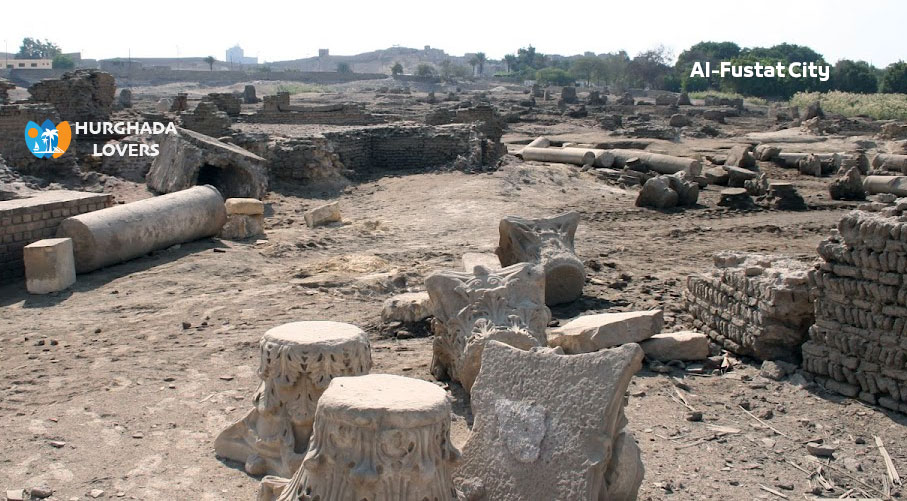Al-Fustat City in Cairo, Egypt | Facts, History Egypt’s first Islamic capital and more about Tourist Attractions in Al-Fustat “Old Cairo”.
The history and facts of building the most important and oldest Islamic capitals in the civilization of ancient Egypt, and what they contain of historical monuments and tourist attractions, what are the working hours, prices for entry tickets and more.
The city of Fustat was the first capital of Egypt to be established under Islamic rule. It was built by the great Muslim leader Amr ibn al-Aas immediately after the Islamic conquest of Egypt in the year 641 AD.
Fustat was also the capital of Egypt even for nearly 500 years. And that was after the founding of the Islamic city in the year 641, but its authority did not cease until 750, when the Abbasid state in Egypt launched a major revolt against the Umayyads.
Hurghada lovers Offer Luxury Hurghada to Luxor Tours | El Gouna to Luxor Tours | Makadi bay to Luxor Tours | Sahl Hasheesh to Luxor Tours | Soma bay to Luxor Tours.
Al-Fustat City
When and by whom was the Al-Fustat City built?
The city of Fustat was built in the year 641 by the great Muslim leader Amr ibn al-Aas, with the help of the Muslim leader Ubadah ibn al-Samit. He also had supervised the worship of the Muslim himself at the time on the construction of the Amr Ibn Al-Aas Mosque, to the extent that he supervised, including the qiblah.
As these early inhabitants of the city consisted almost entirely of a number of soldiers and their families, the layout of the city at that time was quite similar to that of the garrison.
Amr also intended that the city of Fustat would be a base through which the North African region would then be conquered, in addition to launching a larger number of campaigns against the Byzantine division.
But it had remained the main base at that time for Islamic expansion in the region of Africa until it succeeded in establishing the Kairouan region in the city of Tunis in the year 670.
The reason for this name
As for the reason for calling this name, we point out that Amr ibn al-Aas, the Muslim leader, as al-Tabari mentions, was after the completion of the opening of the great Babylonian fortress, he wanted to raise Fustat and then march to the city of Alexandria in order to succeed in conquering Egypt. He left it at that time as it was, and then the owner of the fort and palace recommended him at that time.
This is when he succeeded in conquering the city of Alexandria, and he had wanted to settle in this city, and Omar Ibn Al-Khattab at the time forbade him to do so.
He even advised him at the time to choose a place in the middle so that it would be easy to communicate with him. At that time, Amr did not find it more appropriate than to choose that location close to the fortress of Babylon, which is under his protection, which is the city of Fustat now, considering its name is the center or the impregnable fortress.
Al-Fustat City landmarks
Amr Ibn Al-Aas Mosque
Where it is considered the first mosque that had already been erected in Egypt, and was known at the time as the ancient mosque, and in its place there was a cemetery, but when the Muslims descended in its place, the leader Qaisaba bin Kulthum al-Tajibi had taken his position and then was able to bring it down
And then when the Muslims returned from the city of Alexandria to that place, and he had asked Amr Qaisaba in his house to count this matter in that he actually made it a mosque, and at that time he had already given it in charity to the Muslims, and then it was built in the year 21 AH, almost and he then stood on the Liberation accepted by a very large number of the great Companions
Hence, sessions of lessons were actually held in it, some of them were for the purpose of guidance, and others were for the lessons of both jurisprudence and hadith and lessons in the sciences of the Qur’an and even literature.
Babylon Fortress:
That impregnable fortress, where the great Babylon Fortress is now located in the Coptic Cairo region, that is, specifically at the Mar Gerges station in the subway, where Emperor Trajan at the time had already ordered its construction during the period of rule in the second century AD.
This was during the Roman occupation of Egypt, where he restored it and then expanded and strengthened it, the great Roman emperor Arcadius in the period of the fourth century.
the hanging Church
It was called the Hanging at the time because it was built on two of those ancient towers of the fort that was built in the Roman era (Babylon Fort), as it was built by the great Emperor Trajan in that era specifically in the second century AD, as the hanging is already considered to be The oldest Egyptian churches that still remain so far in Egypt.
What is the price of a ticket to visit Al-Fustat City for Egyptians?
● The fee for a Fustat visit ticket for adults is 10 Egyptian pounds
● As for the fees for a Fustat visit ticket for Egyptian students, it is: 5 Egyptian pounds
What is the price of a ticket to visit Al-Fustat City for foreigners?
● The fees for a visit ticket to Fustat are: 20 Egyptian pounds
● If the visitor is a foreign student, the entrance fee is 10 Egyptian pounds

